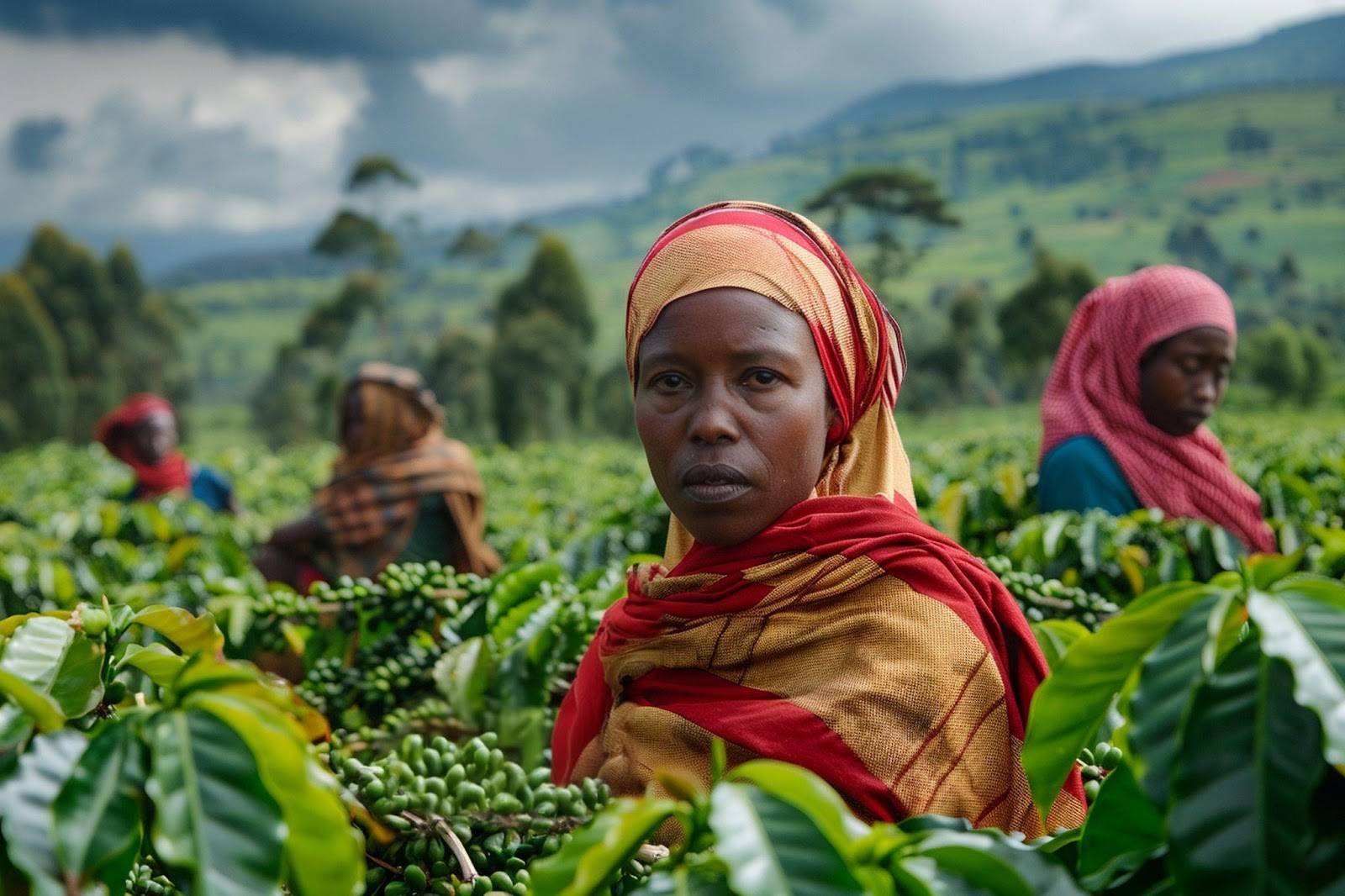Many coffee lovers stuck under the spell of Yirgacheffe’s delicious layered tastes have the same story. Life was alright, enjoying grocery store coffee for years, until one day they happened to be at an event, and there was a stall with a local roaster. They fell for the seller’s charm and ended up buying the tiniest bag of Ethiopian Yirgacheffe. The next morning, right by their drip brewer, life changed. The blueberry notes, the natural sweetness, and the depth of roast flavors shining through the cup are magical. They didn’t know that coffee can taste like violets and plums, and are now entrapped for life.
Ethiopian Yirgacheffe is one of the most distinctive-tasting coffees. The rave among coffee drinkers is valid, especially for the naturals, which have more body and less acidity than the washed varietals. They are also more fruity with tasting notes of blueberry, strawberry, and lemon. Washed Yirgacheffes are mostly acidic and thin-bodied with citrus, tea and floral notes (bergamot and jasmine). Almost like walking into an orange plantation in the blooming season.
Ethiopian Yirgacheffe Coffee Beans - What’s the Big Pull?
People who have had a life-changing cup of Yirgacheffe swear by it being the link to their next coffee venture. The flavors are out of this world, even from a mid roaster. The beans are the gold standard of fruity sweetness in the coffee world. An interplay of factors contribute to Yirgacheffe’s coveted status among coffee connoisseurs:
Suitable ‘Birthplace’ Conditions
Being the birthplace of coffee, it’s no surprise that Ethiopian coffee is among the world’s most renowned tastes. All the wonderful coffees with varied flavors in the world are descendants of Ethiopian coffee. The growing conditions are perfectly suited for consistently producing high-quality coffees. Yirgacheffe (Yer-guh-chef) is one of the major coffee cradles in Ethiopia’s Southern Sidamo. The region has a unique terroir elevated at a high altitude of 1700-2200 meters above sea level. The temperatures are perfectly cool, and the rainfall is ample and consistent for growing Arabica coffee trees.
The cool temperatures contribute to the sweet, fruity nature of Yirgacheffe coffee beans. Because of the cold, the cherries take longer to ripen, allowing the slow but sure development of the signature flavor in the beans. The fertile volcanic soil it grows in also has rich nutrients that impart unique characteristics to the beans.
Genetic Diversity
Ethiopia has the highest coffee genetic diversity. The unique coffee gene pool is attributed to the Jimma Agricultural Research Center (JARC) and the regional/local landrace varieties. JARC develops and distributes different varieties cultivated all over Ethiopia.
The landrace varieties (famously and erroneously referred to as heirloom varieties) are coffee plants that have evolved through selective breeding over many generations and are best-suited for the local growing conditions.
Ever bought an Ethiopian coffee twice from the same origin and roaster and could not believe the difference in flavors? The genetic diversity of the landrace coffee trees combined with the region’s microclimates is one of the reasons behind such vast diversity of flavors, even within the same farm. Yes, you can get two cup profiles from trees on the same Yirgacheffe farm; one may have notes of peach and strawberry and yet another, an outright blueberry bomb with wine-like acidity. The wide cup profile breadth will keep you wanting more, with the hopes of exhausting all the flavors from the region.
Traditional Production Methods
The coffee production methods in Ethiopia include wild-forest grown coffee, semi-forest coffee, garden coffee, and large estate coffee, which is super-rare.
Interestingly, the forest coffee industry is still alive in Ethiopia and holds tremendous economic and cultural significance. The wild arabica coffees are highly sought for their unique gene pool and genetic diversity. In an Interview with Partnerships for Forests, Dr Tadesse Woldemariam, the Executive Director of the Environment and Coffee Forest Forum mentions that the Afromontane rainforests are the country’s cherished high-altitude regions with suitable conditions that support the development of genetically diverse wild arabica beans.
The semi-forest system is the traditional shade-grown method. The locals grow coffee trees under a canopy of shade trees to protect the delicate plants from harsh sunlight, conserve moisture and regulate temperature. The shade promotes slow and even ripening of cherries, resulting in high-quality beans with density, highly concentrated sugars and complex flavor profiles. The method’s only downside is that it requires larger land and is labor-intensive.
Garden coffee is the most common coffee production system in Yirgacheffe. It is done on small farms of less than 5 hectares. Smallholder farmers intercrop the coffee trees with food crops to optimize land use and provide food for their families. The farmers practice organic farming. They hardly use pesticides or fertilizers on the farms, and this contributes to the quality of their produce.
Meticulous Harvesting
The coffee harvest season in Ethiopia is a significant cultural event with intense activity. Harvesting is done manually and mostly involves immediate family and communities. They handpick cherries carefully, only choosing those at the peak of ripeness (bright red) and leave the unripe ones on the branch to mature further. The selected cherry is either processed naturally on the farm before selling at the kebele level or transported to a washing station on foot or by motorbike for processing.
Processing
Coffee processing methods in Yirgacheffe have improved. In earlier times, the farmers dried the harvest on the floor, but now they do it on raised beds for better quality that is acceptable in high-value markets.
Natural/Dry Processing
After selective harvesting, farmers deliver their produce to drying or washing stations with drying beds. The cherries are carefully sorted and the selected ones spread in thin layers on raised beds for sun drying. The raised beds are made with either concrete or woven with locally sourced materials like wire mesh, bamboo or plastic netting. To ensure even drying and prevent rotting, the farmers rake and turn the cherries regularly for about four weeks (depending on the weather conditions) until the process is complete.
In the drying process, the outer layers of the cherry (fruit, pulp and parchment) ferment slowly. The fermentation rots the fruit off the bean, imparting fruity notes and sweetness. Who put berries in the coffee? Well, there you go!
Washed/Wet Processing
Washed processing is not as popular as dry processing, especially for farms in remote places. Many farmers are challenged by lack of transport to the distant washing stations. At the washing stations, skilled workers hand-sort cherries to remove under-ripe, over-ripe or spoiled cherries. The good cherries are pulped and washed before drying on beds. Pulping separates the cherry’s skin and pulp from the beans, leaving a sticky mucilage coating. The beans are then fermented for 12-72 hours in tanks to remove the mucilage coating. Finally, the beans are washed and dried on beds. The washing process results in light-bodied beans with bright acidity and floral notes. These characteristics are highly appreciated among specialty coffee experts.
The washed Planet Bean Yirgacheffe has a sparkling acidity, a medium body and tasting notes of jasmine and lemon.
Roasting
Roasting and brewing are a matter of personal preference. Conventional wisdom suggests that Ethiopian coffee (natural and processed) is best when roasted light or medium to highlight and retain its floral-fruity and citric qualities. Some people claim they roast super-light to get the earth and the farmer’s hard work from the bean. From experience, some natural Ethiopian coffees like our Ethiopian Sidamo hold up well under a dark roast and are uber-delicious.
A good roaster considers the characteristics of a bean and its origin. Some beans are great when roasted lightly, others have fantastic versatility and can be light or French roast. Some are great in the middle. What's important is that you enjoy the coffee you buy.
At Planet Bean, our goal is to highlight what makes each coffee special. We roast our coffees in small sample batches to different roast levels, then cup them and collaboratively agree on the roast level with maximum flavor and customer appeal. We do acknowledge that Ethiopian beans are small and dense, thus hold heat and tend to heat up quickly. To fully develop the delicate fruity-floral flavor tones and brightness, we roast slower at lower heat. Our medium roast Yirgacheffe ends up with a rich jasmine aroma and bright citrus, black tea taste.
Ethiopian Yirgacheffe Coffee Beans - Lately
Many avid Ethiopian coffee drinkers have not been satisfied with the motherland’s coffee bean quality lately. Those who were instantly impressed by the cup quality of natural and washed coffees from the region now feel the beans have mellowed. The subtle tasting notes allegations may be true, and here is why:
Different Weather Conditions
As it is with wine, or any agricultural product, different weather conditions make some coffee years good and others miserable. Haile Gebre, a Yirgacheffe native, is a godfather in the coffee industry in Ethiopia. He has been farming coffee since he was 10 years old. He says one of the biggest challenges the industry faces is full dependence on the volatile weather conditions. “Agriculture is a challenge by its nature. We can experience a drought and excessive rainfall in the same year.” Remarks Gebre.
Arabica coffee varieties are fickle and fragile with the climate. The past few years were hard in terms of growing conditions. There was excess rainfall, which affected the crop quality and the natural processing that largely depends on the sun to impart the classic blueberry bomb in Ethiopian naturals.
A Trained Palate
Crop inconsistencies aside, you may simply have grown a more discerning palate (if you didn’t lose it to COVID). The initial novelty is likely to wear off if you repeatedly expose your taste buds to explosive fruity and floral notes.
War
What robs the world of joy more than war? The civil war (2018 - 2022) in Ethiopia is partly to blame for the decline in Ethiopian coffee quality. You may argue that it was only confined to the northern parts of the country and production in the Southwest was not affected, but the supply chain was largely impacted. Restrictions imposed by the government due to the civil unrest in the country led to shortages for some exporters and a few years later, we are realizing the effects. For instance, the Oromia region had an 8pm curfew that hindered trucks from delivering cherries to washing stations; most farms harvest coffee in the morning, aggregate it in the afternoon and deliver at night. Financial restrictions also made life harder for everyone. Increased cost of living, higher prices and constraints from financial institutions made it difficult for producers and exporters to trade coffee.
Planet Bean’s Take
While the points above are all possible causes of challenges and inconsistencies in the Ethiopian coffee industry, we can confidently affirm that great Ethiopian coffee has not disappeared. It is just not in your cup. Our fine catalogue of the most renowned origins, Sidamo and Yirgacheffe, is a pocket of old school deliciousness that anyone who is awakened to good coffee can enjoy.
Barbara Atieno
Nairobi, Kenya

